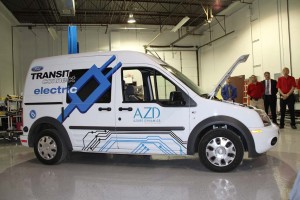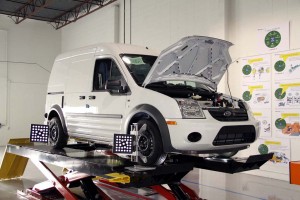
Ford will sell the Transit Connect Electric for $57,400, and expects demand for at least 700 during the coming year.
If it weren’t for the banner blowing in the wind over the front door one might not realize there was a revolution brewing inside the small, non-descript warehouse, along an industrial strip in the Detroit suburbs.
Operated by AM General, the company better known for producing the military’s trademark HUMMVEE, the facility has been quietly converting Ford’s little Transit Connect van to run on electric propulsion. The first several dozen Transit Connect Electric vans will be reaching customers before year’s end. And if they prove successful, 700 or 700 could follow in 2011.
In automotive terms, that’s not much, but as the market for electric vehicles slowly begins to ramp up, that’s nonetheless a significant development suggests Sherif Marakby, who oversees Ford’s electrification program.
The maker had made a hefty investment in battery power back in the 1990s – reluctantly, under pressure from California regulators who had hoped they could mandate a battery car market. The project failed and Ford, like its competitors, slashed its investment in the technology. Now, however, battery power seems to be coming back, in part due to new regulations, but also because of new technologies, as well as public concerns about issues as far flung as global warming and the import of Mideast oil.
Watching rivals like Nissan, with its Leaf battery car, and General Motors, with the Chevrolet Volt plug-in, take the lead, Ford is pushing to jump-start its own battery program. But rather than overload its product development team, the maker has turned to outside partners, like AM General and Azure Dynamics.
The latter firm, based in Canada, was responsible for developing the Transit Connect Electric, while AM General handles production. It receives a “glider” – a version of the van minus a drivetrain – from a Ford plant in Turkey and then installs the Azure Dynamics driveline.
Such joint ventures are “absolutely essential going forward,” insists Rick Smith, president of AM General. And Ford officials agree, noting that by working with their partners they were able to pull the Transit Connect Electric project together in barely a year – while dedicating just five of the automaker’s own full-time employees.
Azure Dynamics, which will serve as the maker of record for the Transit Connect Electric, already has lined up a half-dozen so-called Lead Customers, including AT&T, Canada Post and the utility Southern California Edison. Huston told TheDetroitBureau.com, on Tuesday, that he expects another five fleet customers to sign on “over the next few weeks.”
(For a review of the $57,400 Transit Connect Electric, Click Here.)
Ford’s partnering strategy will permit it to flex whichever way things go. It has teamed up with, among others, the Canadian mega-supplier Magna International’s Magna E-Car venture to develop and build the Ford Focus Electric, a battery version of the next-generation sedan set to launch a year from now.
“Our plan is different from others,” such as Nissan and General Motors, insists Sherif. Indeed, GM CEO Dan Akerson announced earlier this month plans to hire 1,000 new workers, most of them to staff up the company’s battery car program. But, says Sherif, “We like partnerships.”
For now, anyway. The U.S. maker is skeptical of the demand for battery cars, but recognizes a variety of factors could hasten the market’s expansion. Ford is convinced there’ll be a far bigger market for conventional hybrids, and slightly less for the plug-in hybrids it plans to start rolling out in 2012. As for pure battery-electric vehicles, or BEVs? Sherif says they could constitute as little as 1% of the U.S. market by 2020 – “or as much by 5%.”
Should it prove something closer to the latter figure, Ford is “strategically setting ourselves up so we have the capability of doing this ourselves,” Sherif told TheDetroitBureau.com following the preview of the new Transit Connect Electric at the AM General facility, on Tuesday. “We would transition to doing more of this in-house.”
That’s why the next two years will be critical, he says. “We will know a lot more” says Sherif, after watching the market’s response to the new battery van – and the battery conversion of the Focus.
Among the questions Ford hopes to answer is not just how big a market there might be for battery-electric vehicles, but where? While Nissan and Chevrolet have targeted the retail market, there are strong signs of interest from the fleet side of the industry. General Electric, underscored that potential, last month, when it announced plans to convert half of its vast sales and delivery fleet to battery power. (For more on that announcement, Click Here.)
During the Transit Connect Electric preview, officials pointed to U.S. Department of Transportation data showing the vast majority of fleets – such as the U.S. Postal Service – clock barely 40 miles a day per vehicle, well within the battery van’s 80-mile range.
For his part, Ford’s Sherif suggests “our assumption” is that the mix of fleet versus retail demand for battery power “will be around 50/50” over the course of the next decade, while Huston argues that “fleets will (take the) lead.”
Whichever way things go, Ford hopes to be well-positioned to flex with the market.

